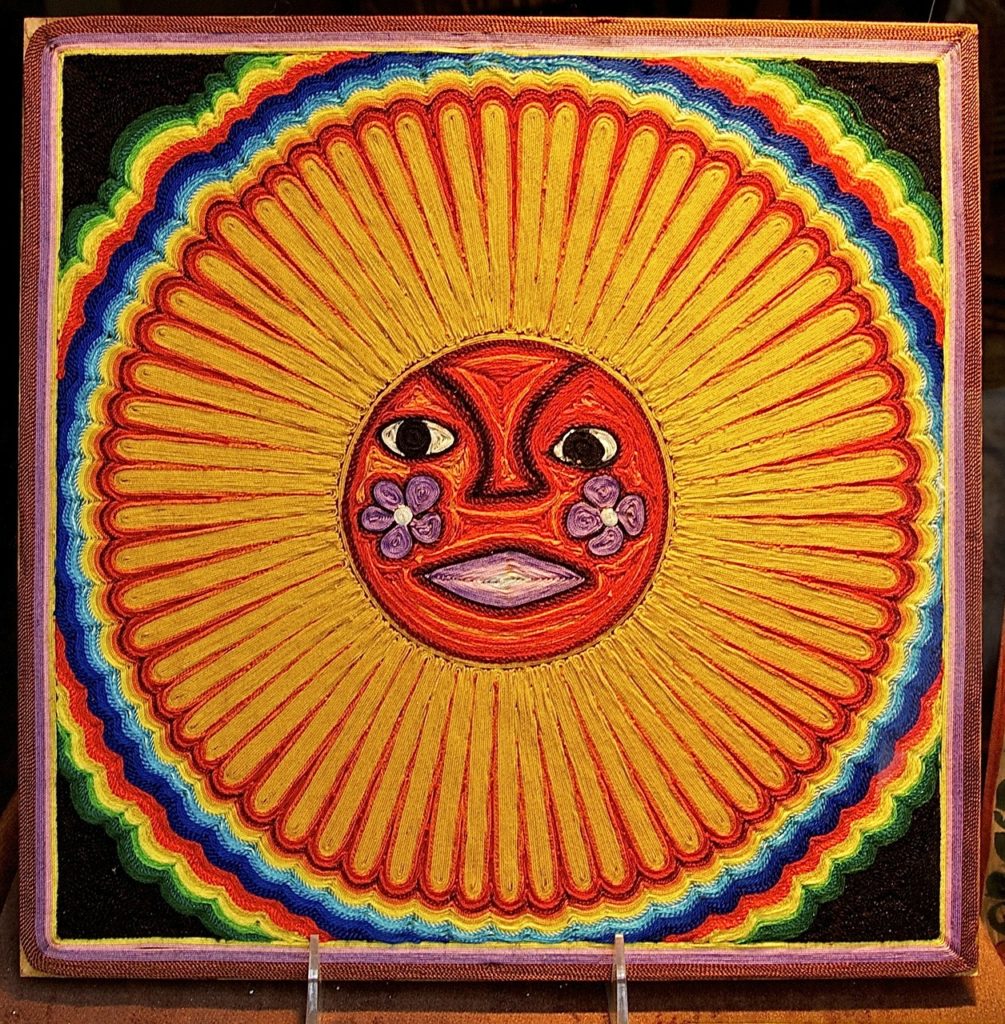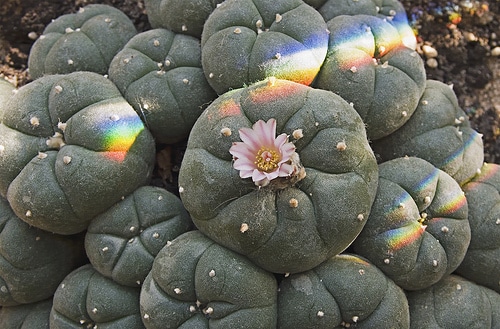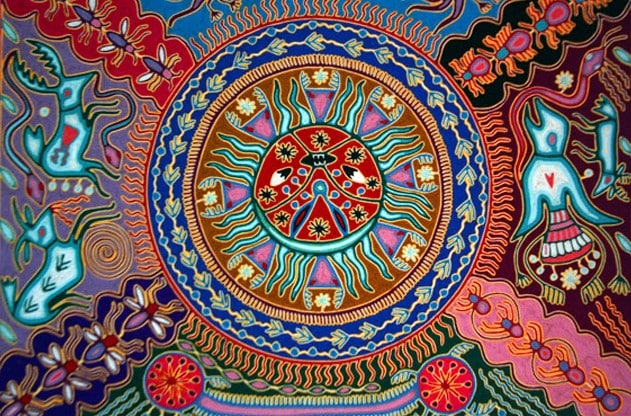An Essential Understanding of Peyote

“In consciousness dwells the wondrous, with it man attains the realm beyond the material, and the Peyote tells us, where to find it.” – Antonin Artaud
What is Peyote?

Peyote, or Lophophora Williamsii, is a type of entheogenic cactus native to the Chihuahua desert region of Mexico and can also be found in states of Tampaulipas, San Luis Potosi, and southwest Texas. This small, round cactus has no spines and it’s “crown” also known as the “button” rarely rises more than an inch or two above the surface of the soil. This sacred cactus produces the hallucinogen Mescaline, as well as a wide spectrum of phenethylamine alkaloids, integral to its visionary reputation. This particular cactus is one of the slowest growing species, taking several years for it to reach flowering maturity.
The peyote crown has disc-shaped buttons that are cut from the plant, and dried. The dried buttons can be chewed, or soaked in water to create a medicinal liquid. Native Americans believe in its curative properties and its use as a home remedy for tooth-aches, arthritis, nerve spasms, fever, breast pain, skin disease, rheumatism, diabetes, colds, blindness, and hearing disorders. It’s also been used to help treat depression, alcoholism and drug addiction. Peyote contains high levels of Peyocactin, also known as Hordenine (N,N-dimethyl-4-
Historical Use of Peyote
The history of peyote use for a variety of Native American and Northern Mexican tribes date back to the earliest recorded time. A recent dig of a cave on the Rio Grande in Texas, found two species of peyote buttons dating back to over 5,500 years ago. The use of this cactus has been recorded and passed down to a variety of indigenous tribes through their healing and religious ceremonies dating back to well over 2,000 years. Peyote seems to embody the soul of many of these tribes, as it’s defined as a visionary sacrament that can open the doorways to commune with other deities.
The earliest published account of peyote is from Juan Cardenas, around 1591, yet the earliest European recordings of this sacred cactus are from Sahagun, who lived from 1499 to 1590. His first hand observations were a product of his dedication to understanding the Indians of Mexico. His writings described peyote use among the Chichimeca…
“There is another herb like tunas [Opuntia spp.] of the earth. It is called Peiotl. It is white. It is found in the north country. Those who eat or drink it see visions either frightful or laughable. This intoxication lasts two or three days and then ceases. It is a common food of the Chichimeca, for it sustains them and gives them courage to fight and not feel fear nor hunger nor thirst. And they say that it protects them from all danger.”
From early reports, it seems that peyote was drunk while participating in a healing ceremony, or religious ritual. Europeans wrote accounts that forbade the use, as it induces “horrible visions” and “diabolic fantasies”. Although one explanation from a spanish missionary wrote the earliest description of what he experienced during a ritual with the Cora tribe, reporting,
“Close to the musician was seated the leader of the singing, whose business it was to mark time. Each had his assistants to take his place when he should become fatigued. Nearby was place a tray filled with Peyote, which is a diabolical root that is ground up and drunk by them so that they may not become weakened by the exhausting effects of so long a function, which they begin by forming as large a circle of men and women as could occupy the space that had been swept off for this purpose. One after the other, they went dancing in a ring or marking time with their feet, keeping in the middle the musician and choir-master whom they invited, and singing in the same unmusical tune that he set them. They would dance all night, from five o’clock in the evening to seven o’clock in the morning, without stopping nor leaving the circle. When the dance was ended, all stood who could hold themselves on their feet; for the majority, from the Peyote and wine which they drank, were unable to utilize their legs.”
As much as things may have evolved over the centuries, the ceremony still consists primarily of dancing.
In the late 1800s, the Native American Church emerged as a religious organization to help protect the legacy and use of the cactus as a sacrament for ceremonial and ritual practices. Under a recent amendment in 1994 of the American Indian Religious Freedom Act, it states:
Notwithstanding any other provision of law, the use, possession, or transportation of peyote by an Indian for bona fide traditional ceremonial purposes in connection with the practice of a traditional Indian religion is lawful, and shall not be prohibited by the United States or any State. No Indian shall be penalized or discriminated against on the basis of such use, possession or transportation, including, but not limited to, denial of otherwise applicable benefits under public assistance programs. — 42 U.S.C. 1996A(b)(1).
In modern times, we can owe a lot of what we know about peyote to the different writers from the beat generation who explored it’s use and influence. Ken Kesey was peyote inspired to write the book, One Flew Over The Cuckoo’s Nest. Allen Ginsberg’s wrote the poem, “Howl”, partially due to his experience using peyote in the 1950s. Then, in the 1970’s, Carlos Castaneda brought forth a resurgence of interest in peyote and Native American shamanic culture, particularly his book ‘The Teachings of Don Juan”.
Modern Usage of Peyote
Modern use has found its way through recreational settings, as well as through more traditional ceremonies hosted by those affiliated with the Native American Church. As ceremonies differ from tribe to tribe, a variety of places throughout the U.S. offer ceremonies to those willing to explore it’s healing benefits. Most of these “churches” offer some sort of initiatory process which involves the individual to participate in a solitary “spirit walk”, after a day of fasting – or participating in group sessions which involve a teepee/sweat lodge setting, where the group is to meet in gratitude for the recovery of health, the safe return from a trip or voyage, the birth of a child, to name a child, or just a general “thanksgiving”. The experience holds a sacred duality which can awaken a solitary individual, or connect a group of people with a collective intention. Unlike other psychedelic experiences, the peyote ceremony places great emphasis on community, and connection/sharing.
The Peyote Experience

The peyote experience lasts around 5-8 hours, with the onset being around 60-120 minutes. From that point, ascension lasts around 30-60 minutes, segueing into the peak/plateau, which is around 3-5 hours. You’ll begin to descend for the last 1-2 hours, and after-effects will still be present for about 6-8 hours. There’s no “hangover”, however, it is reported that the day after ceremony will leave you feeling rejuvenated, and restored. A peyote trip yields many positive effects ranging from feelings of deep insight, the brightening of colors, closed and open eyed visuals. There is a sense of positive mood altering, in the way of feeling hope, unconditional love, happiness and laughter laced with the interconnectedness of spirit, guiding the understanding purpose, and deep energetic rejuvenation.
As with any hallucinogen, there are also the negative aspects of the experience. When it comes to experimenting with sacred/psychedelic substances, you must approach them with the utmost respect and care. If you have latent mental illness, these substances could awaken the illness and instigate some form of psychosis. If you are currently on antidepressants (SSRIs), these may reduce the effects of the experience – and it is recommended you stop taking them at least two weeks, if not a month, before experimenting with peyote. Other adverse effects are nausea, chest pains, shortness of breath, erratic changes in body temperature, confusion, insomnia, unwanted emotions or feelings of despair, depression, or anxiety, along with unpleasant visions or nightmarish hallucinations, also known as the infamous, “bad trip”. To negate having to experience any negative side-effects, it is important to approach this experience from the proper frame of mind, both mentally, emotionally, and physically.
